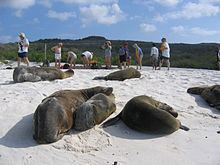Area 60 km² | ||
 | ||
Location Galápagos Islands, Ecuador | ||
Española Island (Spanish: Isla Española) is part of the Galápagos Islands. The English named it Hood Island after Viscount Samuel Hood. It is located in the extreme southeast of the archipelago and is considered, along with Santa Fe, one of the oldest, at approximately four million years. A popular tourist stop, Isla Española is the most southerly island in the Galápagos Archipelago. The climate is very dry, like most of the Archipelago. But due to the flatness of the island, it is the driest of these islands, with only a few inches of rain per year.
Map of Espa%C3%B1ola Island, Ecuador
It is about a 10- to 12-hour trip by boat from Isla Santa Cruz. Tourists come to see the waved albatrosses (from March to January, almost the entire world population breeds on the island) and the mating dances of blue-footed boobies on Española Island.
While Española Island is one of the oldest of the Galápagos Islands, this island is dying, slowly becoming a rocky, barren land with little or no vegetation. But this does give large bays, with sand and soft shingle which attracts a healthy number of Galápagos sea lions
Two spots are especially popular with visitors: Bahía Gardner, which has a lovely beach; and Punta Suárez, of interest because of its varied bird-life. This island has its own species of animals, such as the Española mockingbird, which has a longer and more curved beak than the one on the central islands; the Española lava lizard; the marine iguana of the subspecies venustissimus, which has red markings on its back; among others. Here there are also swallow-tailed gulls and other tropical birds.
